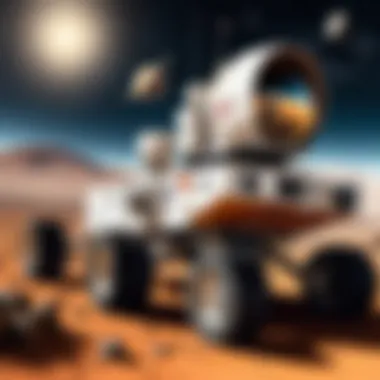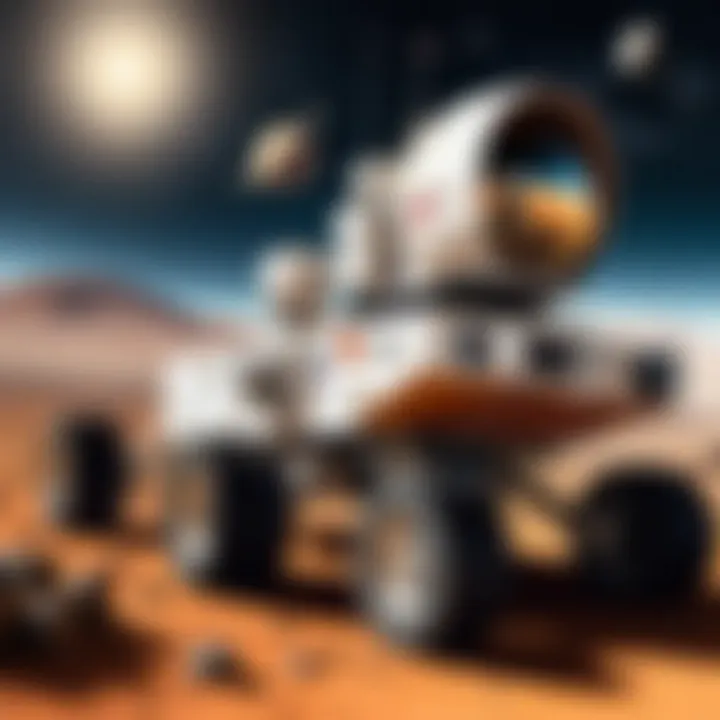The Importance of Space Exploration for Humanity


Intro
In a world that often seems focused on the terrestrial, the allure of the cosmos remains potent and deeply significant. The allure of venturing into the vast unknown has inspired generations and continues to drive humanity's quest for knowledge. Space exploration is not just about the pursuit of science; it's a multifaceted enterprise bearing implications that touch on technological advancement, economic vitality, and even philosophical inquiry.
As we gaze upward, we're also prompting new discussions about sustainability and our place within the universe. The challenges we face on Earth, from climate change to resource scarcity, are echoed in our exploration endeavors. Each step into the cosmos serves as a reminder of the intricate connections we share—not just with one another, but with the very universe itself.
Historical Context of Space Exploration
Understanding the historical context of space exploration is crucial, as it lays the foundation for how we perceive our journey beyond Earth. It not only encapsulates the dramatic events that spurred technological advancements but also delves into the socio-political factors that have pushed humanity to reach for the stars. From the dawn of rocketry to the establishment of international space agencies, this history offers insights into human ingenuity and the quest for knowledge.
The Space Race
The Space Race, a period marked by fierce competition chiefly between the United States and the Soviet Union, played a pivotal role in shaping modern space exploration. Sparked by the launch of Sputnik 1 by the USSR in 1957, this competition fueled rapid advancements in aerospace technology. Both nations viewed success in space as a demonstration of national superiority. The fear of being outpaced in scientific achievement generated a fervor that transcended mere politics, igniting public interest and recruiting minds across various fields to contribute to space endeavors.
During the Space Race, advances were made not just in technology, but also in our understanding of human capabilities in space. The Apollo program, culminating in the landmark Moon landing of 1969, exemplified this commitment. It wasn't merely about being first; it epitomized the collaboration of engineers, scientists, and government officials, all united by a common goal. The inspiring success left an indelible mark on our culture, reinforcing the idea that humanity could achieve extraordinary things when faced with challenges.
Early Space Missions
Before the manned missions that captured global attention, early space exploration set the stage for what was to come. The launch of the Vostok 1 in 1961, carrying Yuri Gagarin—the first human in space—opened a new chapter in human history. This mission challenged what was thought possible and propelled human curiosity forward. Experiments conducted during these early flights provided valuable data on how living organisms react to the harsh environment of space, giving us a foothold to plan for longer and more complex missions.
In contrast to these pushes by government programs, several private entities also began to explore the potential of space. The launches of satellites like Explorer 1 and the geographical data collected from them showcased the burgeoning role of technology in shaping our understanding of Earth and beyond. The Tethered Satellite System work paved the way for numerous applications, affecting sectors from weather forecasting to global telecommunications.
The Moon Landing and Its Impacts
The successful Moon landing on July 20, 1969, was more than just a triumph of technology; it was a profound moment of unity for mankind. Neil Armstrong's first step on the lunar surface symbolized not just individual achievement but also a shared human endeavor. The interplay of science, politics, and culture during these times had a ripple effect that shaped global perspectives on science and technology.
The impacts of the Moon landing extended far beyond the mission itself. It spurred interest in STEM fields among young people, catalyzing educational initiatives and leading to innovations that benefited everyday life on Earth—in fields like materials science, medicine, and environmental studies. Tying back into today’s debates on international cooperation and sustainability, the Moon landing showcased what collective effort and shared dreams could achieve.
"We choose to go to the Moon in this decade and do the other things, not because they are easy, but because they are hard" - John F. Kennedy
In summation, the historical context of space exploration acts as a window into the psyche of human ambition. The Space Race set the groundwork, while early missions provided the necessary data to push boundaries. When humans walked on the Moon, it illuminated a path forward, inspiring generations and prompting a reevaluation of what we as a species could achieve in uncharted territories.
Scientific Advancements through Space Exploration
Space exploration serves as a cornerstone for scientific progress, pushing us to grapple with questions that, while tantalizing, have often eluded easy answers. It’s not merely about sending rockets into the vast unknown; it's about unlocking secrets that inform our understanding of the universe and our place within it. The ripple effects of this pursuit touch on many facets of scientific inquiry, leading to medical breakthroughs, better technologies, and a deeper understanding of the physics that governs existence itself.
Understanding Fundamental Physics
The frontier of space offers a unique laboratory for physicists. By studying cosmic phenomena—like black holes, cosmic rays, and gravitational waves—scientists can observe the laws of physics in extreme environments. For instance, experiments conducted aboard the International Space Station (ISS) have shed light on fundamental questions about matter and energy.
One key example is how conducting experiments in microgravity can reveal behaviors of fluids and materials that are otherwise hidden on Earth. The fundamental knowledge gained is crucial not just for space science, but also for practical applications, such as materials science, which directly influences technology development on Earth. Moreover, missions designed to study the behaviors of atoms at extreme temperatures contribute significantly to quantum physics, paving the way for innovations in computing and telecommunications.
Astrobiology and the Search for Life
Astrobiology stands at the intersection of space exploration and life's potential beyond Earth. The search for other life forms raises questions about our own existence and lends a philosophical flavor to the scientific endeavor. Notably, missions to Mars, like the Perseverance Rover, aim to gather soil samples that could hold microbial fossils, hinting at past life on the Red Planet.
Not only do these efforts stimulate scientific curiosity, they engage the public imagination. Finding evidence of life, even ancient or microbial, would change our understanding of life's resilience and adaptability, potentially expanding the definition of habitable environments. This information is critical when considering future missions to moons like Europa, which hosts an ocean beneath its icy crust. The implications stretch beyond mere curiosity; they will influence how we think about biology, evolution, and even our role on Earth.
Planetary Science and Geo-Research
Planetary science relies heavily on the information gathered from space missions to decode the histories of celestial bodies. The data collected from interplanetary missions enrich our understanding of geological processes not only on Mars or Venus but also back on Earth. For example, missions like the Mars Reconnaissance Orbiter have mapped the Martian terrain in extraordinary detail, revealing features linked to water movement—crucial in understanding past climatic conditions and even the potential for life.
This branch of science informs our geo-research practices on Earth, especially in relation to climate models and natural resource management. By analyzing patterns seen on other planets, geologists can gain insights into phenomena such as volcanic activity and tectonic shifts. Furthermore, the comparison between Earth and other planets allows scientists to hone predictive models regarding geological changes and resource availability on our home planet.
"The cosmos is all that is or ever was or ever will be."
— Carl Sagan
Exploring celestial bodies has opened pathways to understanding the Earth’s own systems. Grasping the complexity of planetary atmospheres can lead to improved climate predictions, which is vital at a time when climate change poses dire challenges.
In summary, the advancements in scientific knowledge spurred by space exploration serve multiple purposes. They not only answer some of the most profound questions about our universe but also enhance technological capabilities and deepen our understanding of Earth. The intersection of fundamental physics, astrobiology, and planetary science creates a fertile ground for discoveries, enriching humanity's intellectual landscape and impacting modern life far beyond the confines of our planet.


Technological Innovations Stemming from Space Efforts
Technological innovations derived from space exploration are not mere side effects; rather, they serve as the bedrock for a multitude of tools and systems we rely on today. The pursuit of knowledge and advancements within the harsh realms of space has prompted scientists and engineers to push their limits, creating solutions often unthinkable in a terrestrial environment. As we look into the specifics of these innovations, one must appreciate the resilience and ingenuity of human quest for exploration.
Advancements in Engineering
The engineering feats required for successful space missions are astonishing. From crafting lightweight materials that can survive extreme temperatures to developing propulsion systems that enable vehicles to break free of Earth’s gravitational grasp, engineers have gone above and beyond. Materials like carbon-fiber composites, born from these investigations, have found their way into everyday products. Not only do these materials enhance durability, but they also improve performance in numerous sectors—think of how aircraft and even sports cars now benefit from these advancements.
Moreover, the techniques used for assembling spacecraft have driven innovations in automation and precision manufacturing. Engineers began implementing sophisticated robotics, algorithms, and sensors to minimize human error. Thus, today’s factories often utilize these advancements to streamline processes and ensure high standards of quality control.
"The advancements in engineering fueled by space exploration stand to reshape not only the aerospace industry but also integrate seamlessly into various everyday technologies."
Satellite Technology and Communications
Let's not overlook the revolution in satellite technology. The development of satellites has been a game changer in communication, weather forecasting, and global positioning. These high-tech devices float gracefully in the void of space, keeping us connected and informed. For instance, GPS systems, foundational for navigation in cars and mobile apps, rely on satellites to function. Without the innovations stemming from space exploration, our travel and logistics modalities would not be as effective.
Furthermore, satellites have made significant contributions to environmental monitoring. They help track natural disasters, monitor climate changes, and even watch over endangered species. It’s fascinating to think how a small piece of tech in orbit can provide critical information to fight fires or predict floods hundreds of miles away.
Spin-off Technologies and Their Applications
From seemingly far-fetched missions on the final frontier, spin-off technologies emerge—products and services that were either directly or indirectly influenced by space-related endeavors. This may sound like something out of a science fiction novel, but it is very much a reality. Technologies that trace their origins to space research include advanced medical imaging techniques, which leverage space tech to improve diagnostic capabilities. Moreover, everyday items like smoke detectors and water purification systems also owe their existence to innovations made during space missions.
- Medical Devices: Development of new imaging devices like MRI and CAT scans.
- Consumer Electronics: Miniature cameras, like those used in smartphones, which have roots in the technology used for space imaging.
- Environmental Tools: Efficient water purification methods spawned from the need to recycle water aboard spacecraft.
Economic Perspectives on Space Exploration
Space exploration is often perceived as a realm reserved for scientists and astronauts, but its economic implications touch a broader spectrum of society. The investments in space initiatives yield not only advanced technologies and scientific knowledge but also substantial economic growth and opportunities. This section elaborates on critical components including return on investment, burgeoning commercial ventures, and the significant creation of jobs and skill development.
Investment and Return on Space Programs
The financing of space programs raises a vital question: what does humanity gain in return for its investment? Some critics may argue that the funds allocated to space exploration could be channeled toward pressing earthly issues. However, it's critical to understand the multi-layered return on these investments.
For example, NASA's budget, approximately $24 billion in 2021, brings back value multifold through technological advancements. From satellites that assist in tracking climate change to medical technologies that enhance healthcare, the benefits ripple across sectors. The development of materials like foamed titanium, initially crafted for spacecraft, has found its way into industries like construction and automotive—proving that something designed for lunar landings can end up in everyday vehicles and buildings.
"For every dollar spent on NASA's space programs, approximately $10 is generated in economic returns through technological innovations and job creation."
Moreover, the economic impact isn't only confined to direct returns. Space programs lead to collaborations among private industries, universities, and governments, fostering an environment rich in innovation. Such landscapes are fertile grounds for developing skills critical to the future job market, which is surely drenched in technology.
Commercial Space Ventures
A significant shift in the space economy emerged with the rise of commercial space ventures. Private companies, such as SpaceX and Blue Origin, have begun to carve out their niches in an industry once dominated by government entities. These companies are not just providing launch services but are also innovating new technologies that disrupt traditional paradigms.
Take the Falcon 9 rocket developed by SpaceX; its reusability is a game changer, substantially lowering costs. This paves the way for more frequent launches and opens the door wider for satellite communications, Earth observation, and even interplanetary missions. In fact, the commercial space sector is projected to balloon into a $1 trillion industry over the coming few decades, thus underscoring the significance of private investment in enabling ambitions that were previously thought impractical.
Additionally, partnerships like those between NASA and private firms often yield benefits, enhancing operational efficiency while spurring technological progress. The synergy between public and private sectors is a pivotal part of the economic landscape that defines space exploration today.
Job Creation and Skill Development
The allure of space exploration does not just lie in its scientific marvel but also in its capacity to create jobs and foster skills necessary for the modern economy. Stakeholders in the space field are keenly aware that workforce development is crucial to sustaining advancements.
Programmes aimed at training engineers, scientists, and technicians contribute significantly towards skill upliftment. Positions span a wide range; from software engineers working on spacecraft navigation systems to workers building and testing satellite components. As of late, around 300,000 individuals are employed within the U.S. space sector alone, and this figure is projected to rise.
Moreover, exposure to cutting-edge technologies and methodology, coupled with interdisciplinary collaborations, enhances academic and vocational education. Universities are increasingly adapting their syllabus, localizing space-related subjects and practical experiences into their programs. This has led to a new generation of students equipped to tackle the challenges of tomorrow's technology-driven economy.
Philosophical and Cultural Impacts of Space Exploration
The exploration of space does more than push the boundaries of human knowledge; it fundamentally alters our perception of existence and culture. As we gaze into the cosmos, we confront profound questions about our role in the universe. Moreover, engaging in space missions fosters a rich tapestry of inspiration and collaboration that resonates far beyond scientific data or technological advancements.
Humanity's Place in the Universe


Understanding our existence is a foundational question that has vexed philosophers and scientists alike for centuries. Space exploration brings us face-to-face with the enormity of the universe, often making our terrestrial concerns seem trivial by comparison. Observations from missions like the Hubble Space Telescope have revealed galaxies billions of light-years away, reshaping our comprehension of time and space. The realization that Earth is a mere speck in a vast cosmic sea can ignite existential reflections: What does it mean to be human, and what is our purpose?
As we venture further into space, such inquiries gain urgency. The discovery of potentially habitable exoplanets challenges our notions of life beyond Earth. Are we unique creatures, or are there other intelligent beings contemplating their own existence? Questions like these elevate the importance of space exploration beyond mere technological triumphs, positioning it as a catalyst for deep philosophical dialogue.
Inspiration for Future Generations
Perhaps one of the most impactful effects of space exploration is its ability to inspire. For generations, iconic moments, such as the Apollo 11 Moon landing, have sparked a fire in countless hearts. Young minds, captivated by the thought of travelling to distant planets or uncovering the mysteries of black holes, might pursue careers in science, technology, engineering, and mathematics (STEM).
Programs aimed at educating young students about space, such as NASA's "Moon to Mars" initiative, are crucial in nurturing this inspiration. Through hands-on experiments, educational outreach, and immersive experiences in virtual reality, children can envision themselves as future pioneers of space. This path not only promotes individual aspiration but also emphasizes teamwork, problem-solving, and resilience. In an age where information can be overwhelming, embedding curiosity and ambition in younger generations helps ensure a brighter, more exploratory future.
Shifts in Worldview and Perspective
Space exploration brings about a collective shift in worldview. When we observe Earth from space, as seen in the famous "Earthrise" photo taken during the Apollo 8 mission, it becomes clear that borders, cultures, and conflicts are constructs seen from an extraterrestrial viewpoint. This shifted perspective often leads to a deeper appreciation for our shared humanity and the fragile ecosystem we inhabit.
Moreover, this understanding encourages international cooperation. Historically, the Cold War fuelled competition in space; however, modern efforts often emphasize collaboration. Programs like the International Space Station (ISS) allow multiple nations to work together. Astro-nauts of various nationalities contribute to the scientific pursuit, melding diverse cultural insights.
Visions of a united effort to explore the cosmos remind us that while we may differ in language, ideology, or customs, our shared curiosity unites us. As we navigate the challenges of our time—be it climate change or social inequities—understanding that we are all journeying together through the universe lends a solidarity that echoes far in the realms of philosophy and culture.
"We are a way for the universe to know itself." - Carl Sagan
International Collaboration in Space Exploration
The endeavor of exploring space transcends any single nation. It’s a collective ambition, one that thrives on collaboration between different countries and cultures. International partnerships in space exploration are not just beneficial; they are critical in tackling the vast challenges associated with venturing into the cosmos. As nations join forces, they enhance their capabilities, pool resources, and share vital knowledge, sharpening the edge of human exploration.
Collaborative Missions and Projects
In recent years, collaborative projects like the International Space Station (ISS) stand as a testament to what can be achieved when nations set aside differences. Built through the cooperation of countries like the United States, Russia, Europe, Japan, and Canada, the ISS is more than just a scientific lab; it's a symbol of unity in a time when division might seem easier. It's a unique environment where scientists from diverse backgrounds come together to study everything from human biology to materials science in microgravity.
"The ISS is proof that when humanity looks beyond itself, we can achieve great things."
Other initiatives, like the Mars 2020 mission which includes contributions from various European organizations, demonstrate the expanding network of cooperation. These missions underline the point that working together can lead to shared success, allowing nations to share costs and risks while boosting their scientific reach into the unknown.
Global Treaties and Agreements
The framework for international cooperation is bolstered by treaties and agreements, like the Outer Space Treaty of 1967. This historic agreement provides a foundation for how nations engage in space exploration. It stipulates that outer space is the province of all mankind and prohibits any claims of sovereignty over celestial bodies. This helps to regulate activities in space, promoting peaceful collaboration.
It is also vital to recognize the agreements that ease data sharing and technology transfer between countries. For instance, bilateral agreements lead to resource sharing, different countries can exchange satellite data for climate monitoring, enhancing our understanding of global changes. The beauty lies in how these treaties facilitate mutual goals, shaping a constructive atmosphere for exploring the final frontier.
Cultural Exchange and Cooperation
The interplay of culture is another dimension of international collaboration in the realm of space exploration. Through joint missions and projects, scientists and engineers are not just sharing technical expertise; they are also exchanging ideas, perspectives, and cultural nuances. This cultural exchange nurtures innovation, opening up fresh pathways for creative solutions to complex problems.
Space camps and educational programs often involve international students, cultivating a sense of shared purpose among the next generation of explorers. By engaging youth from various regions, these initiatives ignite a collective passion for discovery and foster cross-cultural friendships, ultimately enriching the global community.
In essence, the collaborative efforts in space exploration reflect a growing recognition that the challenges we face—be it environmental, technological, or ethical—are indeed bigger than any single nation. Space isn’t just a physical domain; it’s a realm where humanity can unite for a common cause, discover, learn, and innovate together.
Addressing Global Challenges through Space Research
Space research extends its roots far beyond the realm of curiosity and scientific exploration; it serves as a crucial tool for addressing some dire global challenges we face today. As we stare down issues like climate change, resource scarcity, and disaster management, space technology offers solutions that ground-based efforts often fall short of achieving. The significance of this topic cannot be underestimated; it brings into focus how integral space exploration is to our survival on Earth. Through innovative technologies and findings derived from the vast reaches of space, we can pave the way towards a more sustainable and resilient future.
Climate Change Monitoring
The urgency of climate change cannot be overstated. Human activities, coupled with natural phenomena, have tweaked the climate in alarming ways. Space research acts as a significant ally in this fight. Satellites equipped with sophisticated sensors continuously monitor changes in our atmosphere and surface, providing invaluable data to scientists and policymakers alike. These satellites can track carbon dioxide levels, deforestation, and even ice caps melting.
In this context, NASA’s Earth Observing System (EOS) stands out. Launched to observe the Earth, EOS offers insights into weather patterns, greenhouse gas emissions, and land-surface changes. Such comprehensive observation allows for real-time data collection, which is pivotal in activating immediate measures against climate threats.
"Monitoring global climate with satellite technology is not just an option anymore; it’s a necessity for survival."
Resource Management from Space


The concept of managing resources from space may seem outlandish at first glance, but it is not. Earth’s resources are finite, and as our population continues to burgeon, efficient management is crucial. Satellite technology facilitates resource tracking and evaluation, enhancing efficiency across various sectors, including agriculture, forestry, and water management.
For instance, precision agriculture employs satellite data to optimize crop yield by analyzing soil health and moisture levels. Similarly, remote sensing technologies enable us to monitor freshwater sources, alerting authorities to potential drought or pollution before it becomes unmanageable. Using satellites for resource management brings a level of foresight that traditional methods simply cannot match, enabling us to manage what we have wisely and sustainably.
Disaster Response and Recovery
Disaster situations require swift action and a clear understanding of the unfolding circumstances. This is another arena where space research shines. Satellites assist in disaster response and recovery by providing timely updates and imagery during crises such as hurricanes, earthquakes, or floods. They enable emergency services to map affected areas rapidly and deploy resources efficiently.
For example, during Hurricane Harvey in 2017, satellite imagery helped responders identify flooding hotspots, ensuring that aid reached those in dire need as quickly as possible.
Moreover, the data gathered from space not only facilitates immediate response but also aids in longer-term recovery planning and risk mitigation strategies. By understanding patterns and vulnerabilities through satellite data, communities can better prepare for future disasters, making us all the more resilient.
Ethical Considerations in Space Exploration
Exploring outer space raises not just scientific and technological questions but also serious ethical dilemmas that beckon our attention. As we venture into the cosmos, we must grapple with the implications of our actions on celestial bodies, the potential for colonization, and the responsibilities we owe to future generations. This part delves into critical ethical considerations in space exploration, highlighting the pressing issues that accompany humanity's push into the stars.
The Ethics of Colonization
When discussing the ethics of colonization in space, one can’t help but reflect on the historical precedents here on Earth. Humanity’s track record with colonization has left scars on many cultures and ecosystems, casting a long shadow over the notion of establishing a human presence on places like Mars or the Moon. The essential question boils down to: Are we prepared to repeat the mistakes of history in the vastness of space?
Colonization raises significant concerns about exploitation and the potential erasure of existing systems — be they organic, geological, or even hypothetical ecosystems that might thrive on other planets. Just because another planet is uninhabited by current life doesn’t mean it should be treated like a blank canvas for human use. We are at a crossroads in terms of how we approach colonization ideologically and practically. Precautionary approaches and robust discussions about our motives and methods must precede any initiatives for establishing human habitats beyond Earth.
Preservation of Celestial Bodies
The preservation of celestial bodies is a monumental aspect of our ethical considerations in space. Each body within our solar system tells a story, an untouched narrative that could provide insights into the origins of life and the cosmos itself. The question arises: Should we interfere with the natural state of these celestial objects in our quest for exploration?
Important locations, like Mars or Europa, are not merely resources. They hold potential for uncovering clues about life beyond our planet. The scientific community emphasizes planetary protection protocols designed to mitigate contamination by Earth organisms. This is crucial, as nurturing an understanding of cosmic environments without tainting them educates us about life’s potential elsewhere.
"Preservation in space is not just about keeping these bodies intact; it’s about respecting the inherent value of these worlds."
This preservation ethic informs our mission design and operational practices, ensuring we tread lightly as we explore the great expanse beyond our atmosphere.
The Rights of Future Generations
The rights of future generations stand at the forefront of ethical discussions around space exploration. What legacy are we creating? While venturing into the cosmos offers immense promise, we have to ask ourselves: Are we literally paving the way for future inhabitants, or are we melting away their potential landscapes with our actions today?
The principle of intergenerational equity prompts us to consider how our current pursuits might restrict choices for those who will inhabit Earth and potentially other worlds in the future. Ensuring sustainable practices becomes paramount. This means not only responsibly managing resources but also encouraging open discourse about the ethical governance of space resources. Just as important is the need to involve diverse perspectives in these discussions: voices of scientists, ethicists, and, importantly, the broader public must be represented.
Collectively, these considerations serve to guide our actions and shape our explorative spirit as we navigate the final frontier, stressing the balance we must achieve between discovery and responsibility. The forward-thinking approach inherently respects the complexities of the universe, preserving its mysteries for generations yet to come.
Future Prospects for Space Exploration
As we stand on the precipice of a new era in space exploration, the implications of future endeavors unfold like a cosmic odyssey yet to be written. Anticipating the future of space exploration isn’t merely an exercise in speculation; it touches upon pivotal elements of human curiosity, technological evolution, and our relentless quest for knowledge. From the ambitions of private space corporations to the unyielding drive of national space agencies, the trajectory of space missions is geared towards unlocking the mysteries of the universe.
Upcoming Missions and Projects
The excitement in the cosmos is palpable with several upcoming missions that promise to thrust humanity deeper into the solar system. For instance, NASA's Artemis program aims to take humans back to the Moon by the mid-2020s, establishing a sustainable presence and serving as a potential launch point for future Mars missions. Not stopping there, the planned Mars Sample Return mission is noteworthy; it seeks to bring Martian soil back to Earth, allowing scientists to analyze its composition and perhaps answer the age-old question of life beyond our planet.
Moreover, the James Webb Space Telescope will soon delve into the intricate birth of stars and galaxies that emerged billions of years ago, offering insights into the very fabric of our existence. We can’t overlook China's ambitions with its Tiangong space station, which stands as a testament to international competition and cooperation in low Earth orbit. This is just a glimpse of what’s cooking in the cosmic kitchen.
Technological Trends Shaping the Future
In the realm of technology, several trends are emerging that will undoubtedly shape the future of space exploration. The rise of reusable rocket technology pioneered by companies like SpaceX has revolutionized both cost and logistics, bringing down the price of launching payloads into space. The Falcon 9 with its capability to land back and be reused is a game-changer. Furthermore, advancements in artificial intelligence and robotics are playing a key role in autonomous spacecraft navigation and deployment.
To emphasize the significance of these technological strides:
- Artificial Intelligence aids in data analysis from distant planets, enabling faster processing and decision-making.
- 3D Printing is now being explored for in-situ resource utilization, where tools and structures are made on the celestial bodies themselves, minimizing the need to transport heavy materials from Earth.
- Drone technology facilitates better exploration of planetary surfaces, surveying areas that are hazardous for human presence.
Potential for Interstellar Exploration
While interstellar exploration may seem like the stuff of science fiction, recent advancements have sparked interest in the possible journeys beyond our solar system. Concepts like the Breakthrough Starshot initiative propose using light sails propelled by powerful lasers to achieve a fraction of the speed of light. This, in theory, could allow us to reach the nearest star system, Alpha Centauri, in a mere 20 years.
Establishing such interstellar missions raises profound questions and considerations:
- Technological Feasibility: Presently, we haven't developed the necessary technology to achieve sustained interstellar travel, but the groundwork is being laid.
- Human Factors: Understanding the psychological and physiological implications of long-duration space travel is paramount, while living in confined quarters for extended periods poses its own challenges.
- Ethical Considerations: As we venture into deeper space, the ethical implications of potentially disturbing extraterrestrial environments must be addressed.
In summary, the future of space exploration is not just bright; it's a boundless canvas woven with opportunities, challenges, and existential questions. The path ahead is complex, yet with every launch and every discovery, we inch closer to understanding our universe and perhaps our own essence within it.







